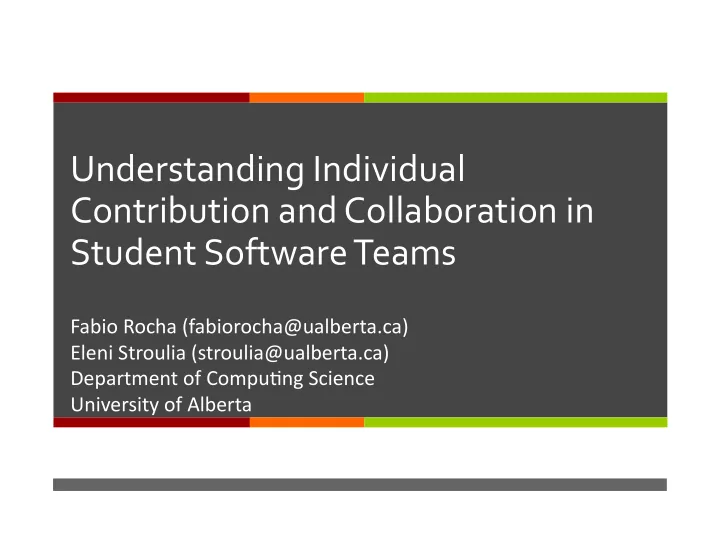

Understanding ¡Individual ¡ Contribution ¡and ¡Collaboration ¡in ¡ Student ¡Software ¡Teams ¡ Fabio ¡Rocha ¡(fabiorocha@ualberta.ca) ¡ Eleni ¡Stroulia ¡(stroulia@ualberta.ca) ¡ Department ¡of ¡Compu<ng ¡Science ¡ University ¡of ¡Alberta ¡
Outline ¡ Mo<va<on ¡and ¡Background ¡ The ¡Tool ¡Architecture ¡ Empirical ¡Study ¡ ¡ Grounded ¡Theory ¡Study ¡ Conclusions ¡ Future ¡Work ¡
Motivation: ¡Collab ¡IDE ¡Data ¡as ¡Answers ¡ Tools ¡that ¡support ¡soIware ¡teams ¡should ¡help ¡answer ¡the ¡ ques<ons ¡that ¡arise ¡during ¡soIware ¡development. ¡ Different ¡stakeholders ¡ ¡are ¡interested ¡in ¡different ¡ques<ons: ¡ ¡ ¡ Developers ¡want ¡to ¡know ¡what ¡other ¡developers ¡are ¡currently ¡doing ¡ to ¡specific ¡soIware ¡ ¡assets. ¡ Managers ¡are ¡interested ¡in ¡higher-‑level ¡informa<on, ¡such ¡as ¡whether ¡ the ¡overall ¡project ¡is ¡on ¡<me. ¡ We ¡are ¡interested ¡in ¡yet ¡another ¡perspec<ve: ¡that ¡of ¡a ¡soIware ¡ engineering ¡course ¡instructor. ¡ 3 ¡
Background ¡and ¡Context ¡ Fritz ¡and ¡Murphy: ¡ ¡ 78 ¡ques<ons ¡that ¡professional ¡developers ¡ask ¡about ¡source ¡code, ¡ change ¡sets, ¡teams, ¡work ¡items, ¡etc. ¡ Myers ¡and ¡LaToza ¡ 67 ¡ques<ons ¡that ¡developers ¡find ¡hard ¡to ¡answer ¡ We ¡focus ¡on ¡ques<ons ¡regarding ¡team ¡dynamics ¡and ¡individual ¡ performance ¡and ¡contribu<on ¡in ¡soIware ¡teams ¡ ¡(encompassed ¡in ¡the ¡high-‑level ¡categories ¡described ¡ ¡by ¡Fritz ¡and ¡ Murphy) ¡ 4 ¡
The ¡Course ¡Instructor ¡Questions ¡ “How ¡student ¡so.ware ¡teams ¡work”. ¡ What ¡was ¡the ¡role ¡of ¡each ¡member ¡in ¡the ¡project? ¡ Was ¡there ¡a ¡clear ¡team ¡leader ¡throughout ¡the ¡project? ¡ How ¡much ¡effort ¡did ¡each ¡member ¡put ¡into ¡the ¡project? ¡ ¡ How ¡much ¡<me ¡did ¡each ¡team ¡member ¡spend ¡on ¡the ¡project? ¡ What ¡work ¡did ¡she ¡do? ¡ How ¡did ¡the ¡team ¡members ¡communicate ¡with ¡each ¡other? ¡ ¡ How ¡frequently? ¡How ¡much? ¡ Through ¡what ¡channels? ¡ How ¡was ¡the ¡progress ¡of ¡the ¡team ¡members ¡throughout ¡the ¡ project ¡lifecycle? ¡ 5 ¡
Proposed ¡Solution ¡ ¡The ¡data ¡ collected ¡through ¡the ¡integrated ¡collabora<ve ¡ soIware-‑development ¡tool ¡ is ¡the ¡spine ¡of ¡the ¡story ¡of ¡ how ¡the ¡team ¡works. ¡ an ¡analysis ¡service ¡ transforms ¡raw ¡data ¡into ¡aggrega<ons ¡ to ¡answer ¡ques<ons ¡of ¡interest ¡for ¡instructors ¡ an ¡interac-ve ¡visualiza-on ¡ enable ¡instructors ¡to ¡explore ¡ the ¡role ¡and ¡contribu<ons ¡of ¡each ¡individual ¡student ¡to ¡ the ¡project ¡and ¡the ¡team ¡dynamics ¡ 6 ¡
Implementation ¡ Architecture ¡Overview ¡ Our ¡framework ¡has ¡a ¡modular ¡architecture ¡ and ¡is ¡built ¡with ¡generality ¡and ¡ extensibility ¡principles ¡in ¡mind. ¡ Any ¡collabora<ve ¡soIware ¡development ¡ IDE ¡that ¡provides ¡similar ¡instances ¡of ¡data ¡ works ¡just ¡as ¡well. ¡ Provides ¡a ¡simple ¡model ¡for ¡developers ¡to: ¡ ¡easily ¡extend ¡the ¡default ¡set ¡of ¡opera<ons ¡ u<lize ¡data ¡from ¡other ¡tools ¡ output ¡data ¡for ¡different ¡types ¡of ¡ visualiza<ons ¡ ¡ 7 ¡
¡ ¡ ¡ Implementation Data ¡Extraction ¡and ¡Analysis ¡ ¡ Two ¡Data ¡Provision ¡services ¡APIs ¡need ¡to ¡ be ¡implemented ¡for ¡a ¡tool ¡to ¡be ¡integrated ¡ with ¡our ¡framework: ¡ ¡ a ¡history ¡service ¡ ¡ ¡ a ¡work-‑item ¡service ¡ ¡ The ¡Analysis ¡Service ¡REST ¡API ¡implements ¡ a ¡number ¡of ¡analyses ¡on ¡the ¡collabora<ve ¡ IDE ¡data ¡extracted ¡through ¡the ¡Data ¡ Provision ¡Services ¡ 8 ¡
¡ Implementation Data ¡Conversion ¡ Maps ¡the ¡Analysis ¡Service ¡JSON ¡output ¡ into ¡JSON ¡used ¡by ¡the ¡visualiza<on ¡client ¡ Fields ¡from ¡the ¡JSON ¡object ¡are ¡mapped ¡to ¡ fields ¡of ¡the ¡visualiza<ons, ¡which ¡translate ¡ directly ¡to ¡aspects ¡of ¡the ¡visualiza<on. ¡ Supports ¡consistent ¡look-‑and-‑feel ¡across ¡ the ¡various ¡visualiza<ons ¡ Consistent ¡color ¡scheme ¡across ¡data ¡ elements ¡ Global ¡data ¡filtering ¡ ¡ Tool<ps ¡and ¡comments ¡ Data ¡audit ¡trail ¡ 9 ¡
¡ Implementation Visualization ¡ Consumes ¡and ¡displays ¡data ¡created ¡by ¡the ¡ analysis ¡service ¡and ¡treated ¡by ¡the ¡data ¡ conversion ¡service ¡ Three ¡different ¡types ¡of ¡interac<ve ¡ visualiza<ons ¡ Aggrega<on ¡Visualiza<ons ¡ Temporal ¡Visualiza<ons ¡ Rela<onship ¡Visualiza<ons ¡ 10 ¡
Aggregation ¡ ¡Visualizations ¡-‑ ¡1 ¡ How ¡much ¡<me ¡on ¡which ¡(types ¡of) ¡work ¡items? ¡ 11 ¡
Aggregation ¡ ¡Visualizations ¡-‑ ¡1 ¡ How ¡much ¡<me ¡on ¡what ¡types ¡of ¡communica<ons ¡with ¡whom? ¡ 12 ¡
Temporal ¡ ¡Visualizations ¡-‑ ¡2 ¡ Who ¡did ¡what ¡to ¡the ¡project ¡plan ¡and ¡when? ¡ 13 ¡
Temporal ¡ ¡Visualizations ¡-‑ ¡2 ¡ Who ¡communicated ¡with ¡whom ¡and ¡when? ¡How ¡much ¡over ¡<me? ¡ 14 ¡
Relationship ¡Visualizations ¡-‑ ¡2 ¡ For ¡a ¡given ¡individual, ¡who ¡is ¡her ¡most ¡frequent ¡collaborator? ¡Over ¡ what ¡communica<on ¡channel? ¡ 15 ¡
Empirical ¡Study ¡ We ¡used ¡our ¡toolkit ¡in ¡the ¡context ¡of ¡a ¡senior ¡undergraduate ¡ soIware ¡engineering ¡course ¡(i.e., ¡CMPUT401). ¡ We ¡studied ¡a ¡six-‑member ¡student ¡team ¡that ¡commiced ¡to ¡using ¡ Jazz ¡and ¡its ¡many ¡func<onali<es ¡to ¡manage ¡their ¡collabora<ve ¡ soIware ¡development. ¡ We ¡also ¡collected ¡perceived ¡data ¡through ¡ques<onnaires ¡and ¡ interviews. ¡ We ¡compared ¡the ¡ informa-on ¡reported ¡ by ¡the ¡students ¡against ¡ the ¡ informa-on ¡observed ¡ through ¡our ¡visualiza<on ¡toolkit. ¡ 16 ¡
Self ¡Perceptions ¡vs. ¡Observations ¡-‑1 ¡ Was ¡there ¡a ¡clear ¡team ¡leader? ¡ Student4 ¡ appears ¡to ¡contribute ¡more ¡ to ¡project ¡management ¡ ¡ He ¡created ¡most ¡of ¡the ¡tasks ¡and ¡ assigned ¡them ¡to ¡team ¡members ¡ BUT, ¡the ¡team ¡members ¡pointed ¡out ¡ that ¡all ¡decisions ¡were ¡made ¡through ¡ a ¡democra<c ¡process ¡and ¡consensus. ¡ 17 ¡
Self ¡Perceptions ¡vs. ¡Observations ¡-‑2 ¡ What ¡was ¡the ¡role ¡of ¡each ¡member ¡in ¡the ¡ project? ¡ A ¡number ¡of ¡work ¡items ¡and ¡ar<facts ¡were ¡ associated ¡with ¡pairs ¡of ¡team ¡members ¡ ¡ ¡We ¡ inferred ¡that ¡the ¡team ¡was ¡organized ¡in ¡pairs ¡ Student2: ¡“We ¡have ¡divided ¡our ¡group ¡into ¡3 ¡pairs ¡ based ¡on ¡the ¡development ¡plaforms. ¡We ¡have ¡ one ¡group ¡doing ¡iOS, ¡one ¡for ¡Android, ¡and ¡one ¡ group ¡working ¡on ¡the ¡web-‑based ¡administra<on.” ¡ 18 ¡
Recommend
More recommend